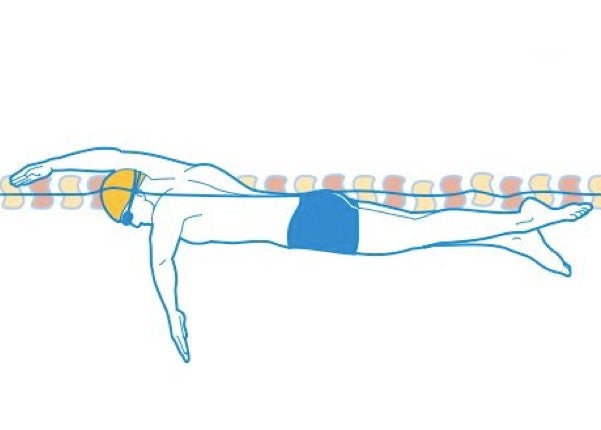The Stroke Series Part Two: Pull & Finish

Illustration by Oliver Baker.
Use the off-season to improve your freestyle stroke with this three-part series from swimming all-star Sara McLarty. Read part one about the reach portion of the stroke here, and then check out part two featuring the pull and finish below.
The most powerful part of each stroke is the underwater pull. Many triathletes are challenged in the water because they are not getting the maximum amount of forward propulsion with each pull. Incorrect arm movements under the water can steer you off course, cause shoulder pain and waste energy. An easy way to understand the correct movement is to imagine drawing a question mark on the bottom of the pool with your fingertips.
Do:
• Relax your fingers underwater and allow a small gap to form between each. Similar to holding your hand out the car window to catch the air.
• Finish each underwater stroke with your arm close to your body and your hand next to your thigh.
• Utilize swim-specific exercises in the gym, such as pulls with resistance bands, to build stronger “pull” muscles.
Don’t:
• Bend your wrist at the beginning of the underwater stroke. Keep your wrist strong and straight.
• Let any part of your arm cross under the centerline of your body.
• Flick your hand out of the water during the finish. Instead, lift your elbow right before your hand reaches the surface.
Step by Step:
Catch the water by letting your elbow pop up at the beginning of each pull while your fingertips angle toward the bottom. Keep your wrist strong and unbending. This motion will naturally force your hand and arm to sweep outward, away from your centerline.
Pull your arm back by rolling your torso toward the arm anchored in the water. You will feel your lats, pecs and upper-back muscles engaged.
Finish each stroke by letting your arm naturally sweep back toward your body as you lose power in those large muscle groups. Your triceps will take over and push your forearm and hand toward your thigh. Do not push your hand out of the water.
Drills:
Tennis Balls: Hold a ball in each hand and swim freestyle. By canceling the force on your palm, you can feel how important the rest of your arm is for creating propulsion.
Hand Paddles: Grasp the paddle upside down without using the straps and check that the top of the paddle extends past your wrist. When you swim freestyle, the paddle will prevent your wrist from bending as you catch the water.
Single Arm: Use fins to make this drill easier. Place one arm at your side and swim a lap only using the other arm. This will allow you to concentrate on the complete stroke. Watch your arm underwater to verify that it is maintaining the correct position.
Check back tomorrow for part three of “The Stroke Series,” featuring the recovery and finish.